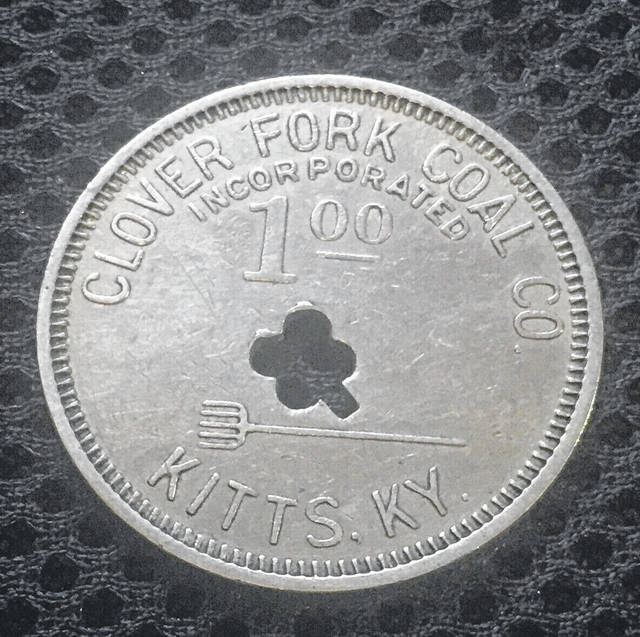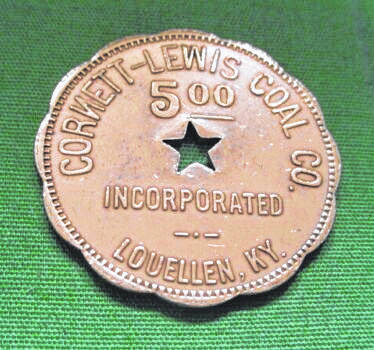


Before you consider reading my column today on coal scrip in a part of southeastern Kentucky and the man who collects it, you might want to consider a brief description of that part of the state when coal began providing jobs in the early decades of the 20th Century. I am referring to “up Cloverfork” in Harlan County.
Most miners had families, but it was rare for them to own automobiles in this part of the county. Roads were sketchy at best with the railroad (essential as a way to transport the mined coal to markets) being the sole reliable way out. There were few banks and they were at a great distance. There were none “up Cloverfork” in Harlan County. Miners could not get loans and had no money to deposit in banks if they could manage to get to the county seat, Harlan. Mining companies often provided modest housing, and scrip became the currency for transactions at commissaries, that is, company stores which sold everything from food and clothing to carbide lamps.
For my Kentucky readers, know that I am not writing about Benham (an International Harvester company town and mining operation) or Lynch (a U.S. Steel town). Although both of these Harlan County communities had commissaries, neither company issued scrip.
Scrip was a line of credit against wages the miner intended to make. Refer to the lyrics of “Sixteen Tons” by Merle Travis, knowledgeable about coal mining from his early years in Muhlenberg County, Ky. The narrator in the song claims to have a weak mind and “a back that’s strong” as he laments his work in the mines and his never-ending indebtedness to the company store.
Each mining company had its own scrip of various denominations, and the value of the coins today depends upon beauty and rarity with pictorial scrip featuring locomotives, nature, American Indians being highly desirable. Additionally, dates on scrip enhance value.
A 1968 graduate of the University of Kentucky and attorney Steve Cawood of Pineville, Ky., a past president of the National Scrip Collectors Association, became interested in scrip when he was a young boy and traveled with his uncle Al Smith, head salesman at McComb Supply, to mines and commissaries. He says, “While my uncle sold to the bosses, I bummed small tokens of scrip from the scrip clerks or swapped U.S. currency for a piece of scrip.”
His mother, a graduate of Stonewall Jackson College for Women in Abingdon, Va., worked as a scrip clerk at the Kentucky Cardinal Coal Company, and he was fascinated with the scrip of that company: bright brass with cardinals. Cawood also saw the satisfaction his mother received building collections of U.S. coins in coin collectors books she bought at dime stores. At one point, she gave Cawood a cigar box of scrip from the company for which she worked.
Readers might be interested in knowing, according to Cawood, that the scrip machines (Osborne Register Company-Orco and Ingle-Schierloh Company) which Cawood’s mother and other scrip clerks used to conduct business with cardboard punch cards were custom made for those Cincinnati-area companies by the National Cash Register Company of Dayton.
Later as Cawood’s legal practice flourished, the claimants with whom he worked, many Black Lung and workers compensation cases, gave him scrip as they knew he valued and collected it.
Cawood’s scrip is stored in a vault at an area bank, and he describes his most valuable scrip: “It’s the first metal coal scrip issued in America, and it’s from The Pine Hill Coal Company in Rockcastle County, Ky. It’s brass and I have five pieces. One piece is dated 1871 and another is dated 1875. The engraver was J. F. Dorman of Baltimore, and pieces of the scrip feature a seated Lady Liberty, an eagle, and a Liberty head. The company mined coal for locomotives so that the L&N Railroad could complete its route from Cincinnati to Corbin, Ky. That coal company was short-lived and the scrip is valued at approximately $500 a token.”
And then there is the scrip Cawood owns to which he is most emotionally attached: “That scrip is directly tied to my family. My paternal grandpa, Steve Cawood, opened the first mine on Martin’s Fork in 1914, the Lena Rue Coal Company (1914 to late 1920s), named in honor of his sister. He died of a stroke when my dad was 11, so I never knew him. After his death, the company was sold to Southern Coal and Coke of Knoxville, Tenn.
In closing, I’d like to give a bit of advice to my readers. When you’re cleaning out your grandparents’ home following their deaths in current or former coal-mining
areas in Pennsylvania, Tennessee, West Virginia, or Kentucky, you might find pieces of scrip in drawers of sewing machines or old cigar boxes or kitchen cabinet drawers. Don’t toss these precious pieces of metal from days gone by.
Edkins Catalogue of Coal Mining Scrip, Fourth Edition, can give you some information about the source of your scrip as a starting point for further research (West Virginia had so many mining companies that it has its own volume, volume two). Using interlibrary loans will not work for these hefty volumes are part of special collections, but if you luck out, as I did, a librarian might send you a few pages via email. You need have only Edkins, the name of the state, and the name of the town.
Also, please know that you haven’t heard the last from me on Steve Cawood. Have you seen Barbara Koppel’s movie “Harlan County, U.S.A.” on the UMWA strike against Duke Power at Brookside, Kentucky? Do you know about the Scotia mine explosions in Letcher County, Ky.? Are you familiar with the extraordinary work of Congressman Carl Perkins? What about the Hyden-Finley-Hurricane Creek Disaster? Or Legal Services Program that dispense legal aid? And what about the ongoing activities of men and women like Cawood who are bent on preserving history?
Editors: Note that the photos are from my son’s private collection, and he prefers his name not be mentioned. I think it’s almost essential to use a photo to illustrate what scrip is.







